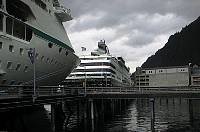|
|
I have included file sizes in the image links. Please take a moment to check these sizes before you begin downloading images for viewing. Several of the JPS files are very large and will be painful to download over a modem link. The images are presented in cross-eye
and anaglyph format. If you prefer a different format or size, please give
the Stereoscope applet a try. |
|
|
|
|
[ Up ] [ Next ]
How to synchronize
 As
soon as I had my pair of A5s, I tried taking a few "finger" synchronized
pairs. I put the cameras next to each other on a flat surface and pressed
the shutter buttons simultaneously with two fingers. The cruise ship pair was
one of these tests. Even in this scene, there was
motion between the frames. My fingers just
weren't precise enough to do the job and I started work on electronically
synching the two cameras.
As
soon as I had my pair of A5s, I tried taking a few "finger" synchronized
pairs. I put the cameras next to each other on a flat surface and pressed
the shutter buttons simultaneously with two fingers. The cruise ship pair was
one of these tests. Even in this scene, there was
motion between the frames. My fingers just
weren't precise enough to do the job and I started work on electronically
synching the two cameras.
On the theory that the shutter release on a digital camera is nothing more than an electrical switch, I decided that I should be able to connect a second (external) switch in parallel with the original. By running these external switches out to a single double pole switch, I would be able to trip both shutters simultaneously. In an ideal world, the double pole switch would contain some optoisolaters, but I decided to start with a simple mechanical switch.
In thinking about the synchronization, I had to think about the camera timing. Most digital cameras have a significant shutter lag. There may be between .25 and 3 seconds between the pressing of the shutter button and the tripping of the shutter. During this time, the camera is metering the scene, precharging its CCD, focusing, and determining white balance and exposure settings. Each camera family behaves slightly differently, and each has different ways to minimize this shutter lag time.
On my Canon cameras (and most others I have tried) the shutter button is a two stage switch. Pressing the button half way down causes the camera to carry out all of its metering and focusing work. The amount of time this work will require is non-deterministic. It may take 1.5 seconds the first time, and 2.5 seconds the second. Pressing the button the rest of the way then triggers the shutter almost instantly. Tripping the shutter in this fashion does not reduce the total shutter lag, but it does allow you to "preload" the lag. By pre-focusing and metering, you are then ready to trigger the camera in the shortest possible time. In my final trigger design, I put the "half press" and the "full press" functions on different toggle switches. This allows me to "half press" on a scene (meter, focus, white balance), be ready for a very rapid shutter trip, and be ready for another exposure (with exactly the same meter and focus information) in the shortest possible time.
So what I needed to do was to take the cameras apart, connect wires to the internal switch, run the wires out the back of the camera and connect them to a couple of switches. How hard could that be?